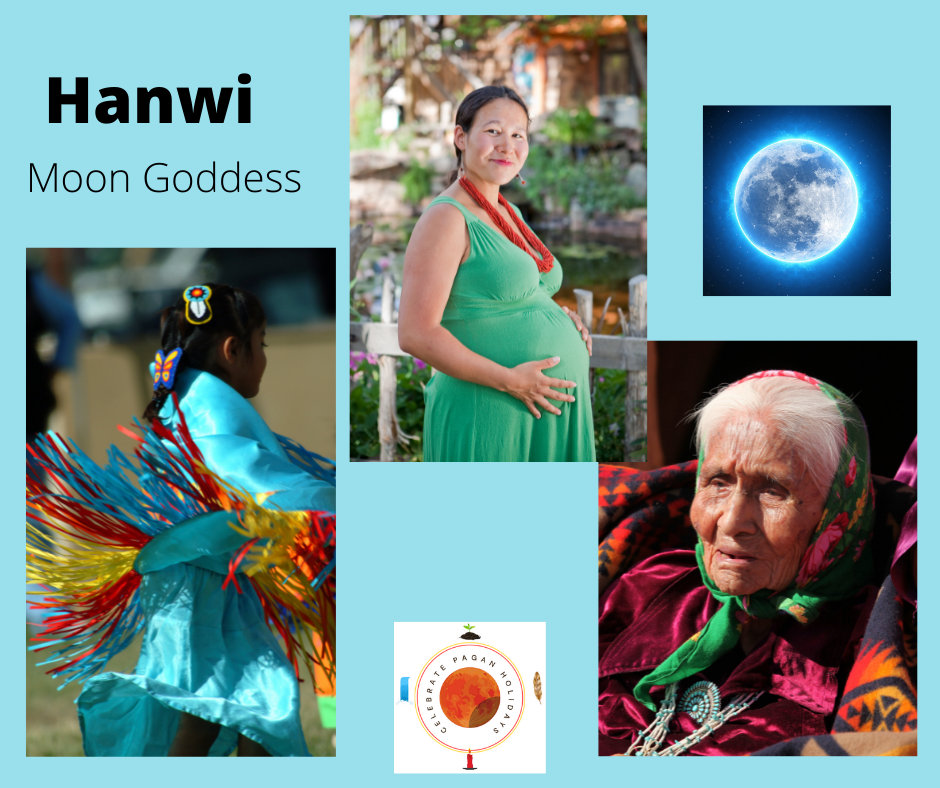Hanwi is the Moon Goddess of the Sioux Tribe of Native American Indigenous people. The Sioux are part of the Dakota and Lakota Nation.
Just like the moon pierces the darkness of the night it is believed that Hanwi pierces the darkness of your soul and protects you from negative beings.
Who is the Goddess Hanwi?
Hanwi is a goddess of the moon. The moon is intrinsically feminine and represents fertility, dreams, emotions, and transformations. She represents the rhythm of natural cycles.
She is also the Goddess of motherhood, feminine power, and watches over women during their monthly cycle.
Who Is Hanwi’s Family?
Hanwi means “Night Sun” and she is married to Wi, the Sun god. Her name “Han” means darkness and “Wi” means sun. Also called Hanhepi Wi (Nighttime Wi).
Where Do The Phases of The Moon Come From?
Hanwi’s husband dishonored her by allowing a mortal to take her seat in the sky. So she often hides part of her face in shame, thus allowing for the phases of the moon.
This is the Story of Why the Moon Has Phases
The Sungod Wi, fell in love with a mortal woman named Ite who had charmed him. The charm made her the most beautiful woman on earth rivaling even Hanwi.
Wi allowed her to take Hanwi’s place at his right side at a banquet of the Gods. Wi and Ite wanted to further her place among the gods.
Ite arrived at the banquet and took the place beside Wi before Hanwi had a chance to sit down. Enchanted by her beauty Wi allowed this. When Hanwi saw Ite sitting next to her husband in a place of honor she was deeply ashamed and hid her face in humiliation.
This caused a great disruption among the Gods.
The Sky god Skan was outraged. Skan the Sky God, was the ruler and judge of the gods. He condemned Wi for his dishonorable behavior and banished Ite to the underworld.
Skan divided the universe. Instead of traveling together across the sky - Wi and Hawni now travel alone. Wi rules by day and Hanwi rules by night. By separating the two he gave Hanwi her place as the moon in the night sky.
To this day, Hanwi the Moon Goddess moves through the night sky still a beautiful woman. However, she is still filled with humiliation and on some nights turns sideways so we don’t see her face, thus creating the phases of the moon.
When the sun is farthest away she faces the sun and we have a full moon.
The phases of the moon represent women of various ages; child, maiden, mother, and crone.
Check out More Moon Goddesses in our blog!
Cleansing
Under Hanwi’s moon is a good time to cleanse yourself and get rid of negative energy.
Crystals for Cleansing
Moonstone and Agate are two crystals that have powerful cleansing properties.
Moonstone is a traditional stone for harmonizing with the ebb and flow of the moon’s energy. Moonstone is translucent and typically comes in shades of white and grey. It represents feminine energy and new beginnings.
The word agate means faithful friend. It comes in a variety of colors and has stabilizing and strengthening influences. Good for grounding work.
Remember to Take Care of Your Crystals.
Menstruation
Hanwi is also the Goddess of motherhood and feminine power.
The feminine moon is associated with the menstrual cycle. In the Sioux tradition, when a woman is on her moon time, it’s a sacred time of rest, renewal, and going within for inner cleansing. Women are at their most powerful during this time.
The Lakota (Sioux) Moon Calendar
The Lakota calendar is divided into 13 months with each month being 28 days long. Every three years an additional moon is added.
The calendar starts in spring. Spring symbolizes the start of a new year through the birth of new plant and animal life.
Spring Wetú — The Moons of Renewal and Growth
Magáksicaagli Wí — Moon When Ducks Come Back
Wíhákata Cépapi Wi — Moon of Making Fat
Wójupi Wi — Moon When the Leaves are Green
Summer Blokétu — The Warm Moons
Wípazuka Wasté Win — Moon of the June Berries
Canpásapa Wi — Moon When the Chokecherries Are Ripe
Wasúton Wi — Moon of the Harvest
Autumn Ptanyétu — The Moons of Change
Canwápegi Wi — Moon When the Leaves Turn Brown
Canwapekasna Wi — Moon When the Wind Shakes off Leaves
Waníyetu Wi — Moon of the Rutting Deer
Winter Waniyetu- The Cold and Dark Moons
Wanícokan Wi — Moon When the Deer Sheds Their Horns
Wiótehika Wi — The Hard Moon
Cannápopa Wi — Moon When Trees Crack From The Cold
Istáwicayazan Wi — Moon of Sore Eyes (Snow Blindness)
Author, Katherine Fox is currently raising a pagan husband and three children. They love getting outside and exploring the natural world. Katherine’s heritage is Native American (Northern Cheyenne and Arapaho) and Irish and she writes about family fun pagan activities, Native American and Celtic traditions.





Crystals need care just like any other ritual tool. They have an energy that comes from the earth that needs to be periodically cleansed or restored.
Crystal care includes cleansing, maintaining, storing, and understanding best safety practices.